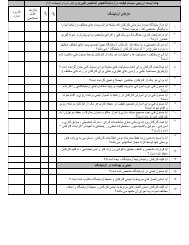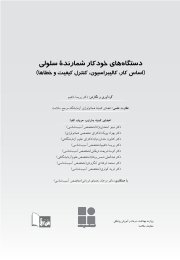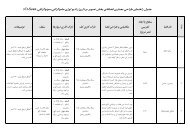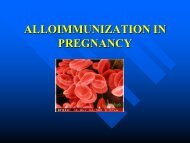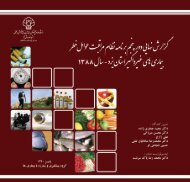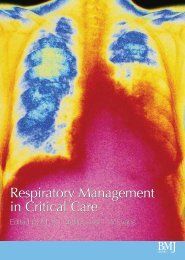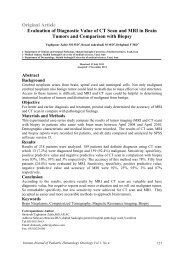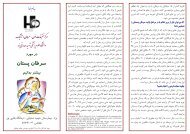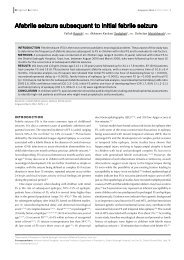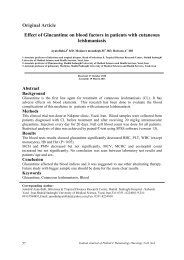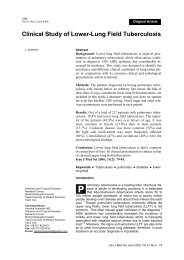Original Article Immunophenotyping of Leukemia in Children ...
Original Article Immunophenotyping of Leukemia in Children ...
Original Article Immunophenotyping of Leukemia in Children ...
- No tags were found...
Create successful ePaper yourself
Turn your PDF publications into a flip-book with our unique Google optimized e-Paper software.
<strong>of</strong> markers <strong>in</strong> ALL patients was CD19 (90.2%), CD10 (84.36 %) and HLA-DR (70.58%) <strong>in</strong>general. It is noteworthy that <strong>in</strong> this <strong>in</strong>vestigation the majority <strong>of</strong> considered population wasALL patients. Based on frequency <strong>of</strong> HLA-DR and morphology type <strong>in</strong> our results, it may beconcluded that ALL prognosis is poor.Review<strong>in</strong>g other studies express that there is a few differences from ours <strong>in</strong> some studies andsome <strong>of</strong> them confirm our results (9, 12 and 13).Asvadi Kermani <strong>in</strong> northwestern, Tabriz <strong>of</strong> Iran (2002) showed the most frequent markers <strong>in</strong>ALL patients were CD7 (11-28%), CD2 (5-21%) and CD19 (3-14%). CD10 (1-5%) andCD20 (9%) were <strong>in</strong> the next positions (10). In this study there was not especial age range.Similarly, Haxia Tong et al (2010) studied on 113 patients with ALL <strong>in</strong> Ch<strong>in</strong>a. In this study,the most prevalent markers <strong>of</strong> B-cells <strong>in</strong>cluded CD19, CD10, CD22 and CD20. Frequency <strong>of</strong>these markers was 99%, 82.5%, 74.8% and 37.5% respectively (9).In general, CD19 was found to be common <strong>in</strong> this and other studies. Wenxiu et al, (2005)achieved those results <strong>in</strong> B-cell l<strong>in</strong>e. They studied on 81 ALL patients <strong>in</strong>clud<strong>in</strong>g 43 childrenand 38 adults. In this <strong>in</strong>vestigation CD5 and CD7 were the most common markers <strong>in</strong> T-celll<strong>in</strong>e (12). It should be noted that there are variety <strong>in</strong> these antigens <strong>in</strong> ALL patients <strong>of</strong>different regions. In research <strong>of</strong> Shen and colleges (2003) on 222 Ch<strong>in</strong>ese patients withleukemia, different results were obta<strong>in</strong>ed. In this population, 124 patients were ALL <strong>in</strong>clud<strong>in</strong>g94 patients with B- cell l<strong>in</strong>e and 30 people <strong>in</strong> T-cell l<strong>in</strong>e. In this study CD13 was the mostcommon antigen and after it, the most frequent markers were CD15 (11.3%), CD11b (6.5%)and CD33 (4.3%) (13).The frequency <strong>of</strong> the different antigens was various <strong>in</strong> various l<strong>in</strong>es <strong>of</strong> ALL. Study <strong>of</strong> Ramiaret al (2007) showed <strong>in</strong> Pre-B1, Pre-B2 and Pre-B <strong>of</strong> B-cell ALL, frequency <strong>of</strong> CD20 <strong>in</strong>creasesand CD10 decreases (14).In present study, the most common markers <strong>in</strong> AML patients were CD45, I3 (HLA-DR) andCD19 <strong>in</strong> M2, CD45, I3 (HLA-DR) and CD34 <strong>in</strong> M3, CD45, CD33, I3, CD34 AND CD64 <strong>in</strong>M4 and CD34, CD45, CD41, CD61 and CD7 <strong>in</strong> M7. CD45 (81.8%), I3 (HLA-DR) (63.64%)and CD34 (54.5%) were the most common antigens.The most markers <strong>in</strong> Asvadi Kermani research were CD13 (71%) and CD33 (74%) <strong>in</strong> M1,CD33 <strong>in</strong> M2 and CD13 <strong>in</strong> M3 (10).Tong HX et al, (2009) <strong>in</strong>vestigated the immunophenotypic subtype pr<strong>of</strong>iles <strong>of</strong> 192 patientswith AML. The results showed the CD33, CD13, myeloproxidase (MPO) and CD117 werethe most commonly expressed antigens <strong>in</strong> AML. CD117 expressed <strong>in</strong> 84.6% <strong>of</strong> AML-M3cases (15). Also Shen et al observed that the most common antigens <strong>in</strong> AML were CD7(12.8%), CD19 (6.4%) and CD2 (5.1%) (12). Sovariety <strong>of</strong> markers is observed <strong>in</strong> differentAML subgroups. Nevertheless, the presence <strong>of</strong> markers like CD34 is remarkable <strong>in</strong> this studysuch that frequency <strong>of</strong> CD34 is 65.1% and <strong>in</strong> our study is 54.5%.In our study, prevalence <strong>of</strong> some markers <strong>in</strong> ALL and AML patients were different from otherstudies and some <strong>of</strong> them were the same. These results could be used for differential diagnosis<strong>of</strong> AML from ALL. Present <strong>in</strong>vestigation was done on a small population <strong>of</strong> children, andfurther studies with bigger sample size will be needed to achieve a clear conclusion.AcknowledgmentThanks to colleagues <strong>in</strong> the oncology department <strong>of</strong> Gorgan Taleghani hospital. This articlehas no conflict <strong>of</strong> <strong>in</strong>terests.Iranian Journal <strong>of</strong> Pediatric Hematology Oncology Vol 1. No 4.119




